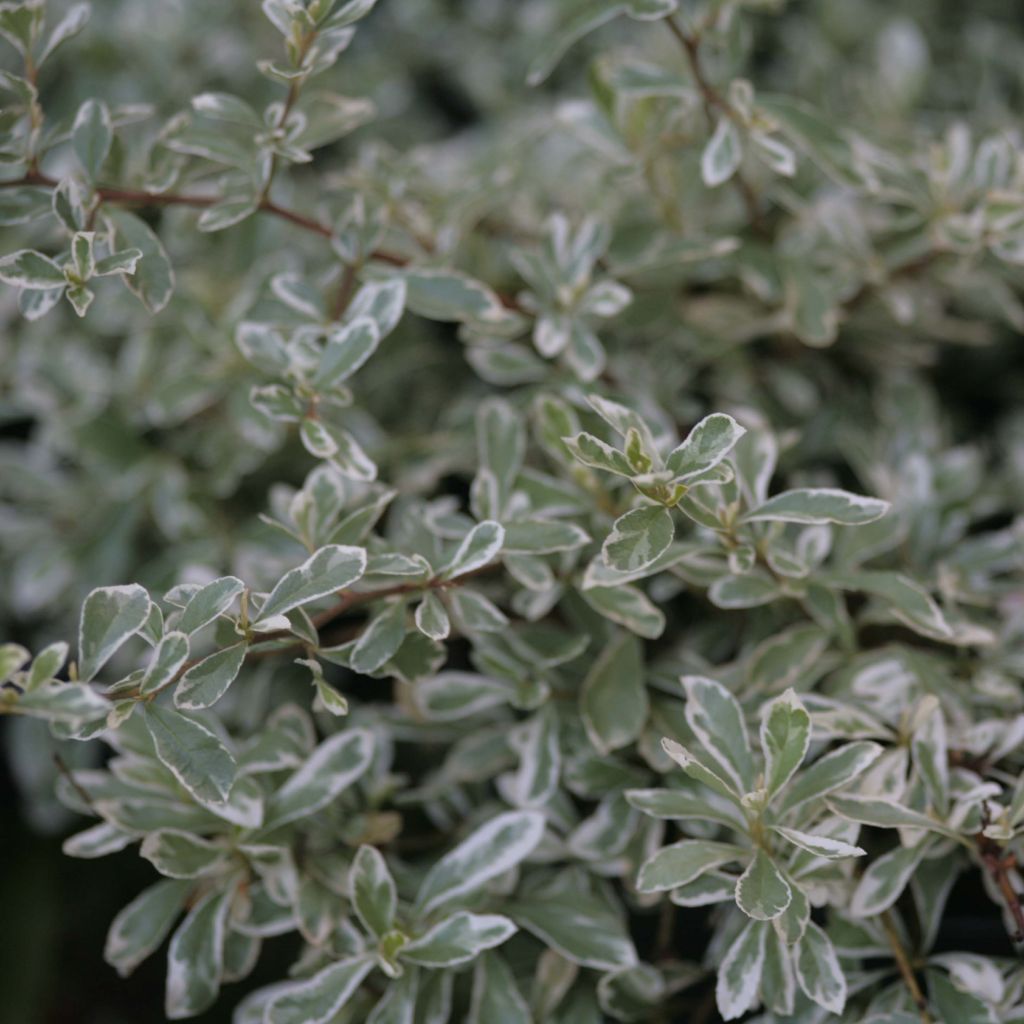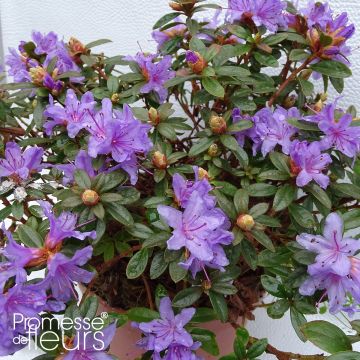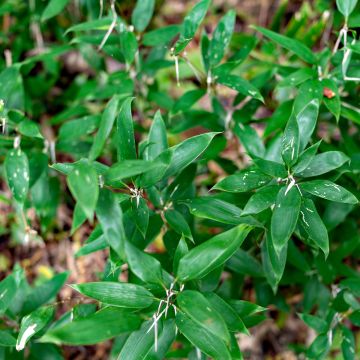

Pyracantha palustris Sparkler
Pyracantha palustris Sparkler
Pyracantha palustris Sparkler
Scarlet Firethorn, Fire Thorn, Pyracanth
After receiving 3 pyracanthas sparkler, intrigued by the fact that there is no picture on the internet of this variety presented with berries (unlike all the others!), I did some research. And I came across the website www.pcsdl.fr which states: "we have never observed fruits on this variety in 30 years of cultivation". However, promesse de fleurs was announcing berries! So, I expressed my dissatisfaction and promesse de fleurs offered me a credit corresponding to the total amount of the 3 bushes. Fortunately, because among them, only one was in good health. The other two were dry. I will probably, as a replacement, order 3 pyracanthas, with berries! Hoping that, this time, the quality will be there!
Marie-Claire , 30/10/2024
Special offer!
Receive a €20 voucher for any order over €90 (excluding delivery costs, credit notes, and plastic-free options)!
1- Add your favorite plants to your cart.
2- Once you have reached €90, confirm your order (you can even choose the delivery date!).
3- As soon as your order is shipped, you will receive an email containing your voucher code, valid for 3 months (90 days).
Your voucher is unique and can only be used once, for any order with a minimum value of €20, excluding delivery costs.
Can be combined with other current offers, non-divisible and non-refundable.
Home or relay delivery (depending on size and destination)
Schedule delivery date,
and select date in basket
This plant carries a 24 months recovery warranty
More information
We guarantee the quality of our plants for a full growing cycle, and will replace at our expense any plant that fails to recover under normal climatic and planting conditions.

Would this plant suit my garden?
Set up your Plantfit profile →
Description
The Pyracantha Sparkler makes a beautiful sight, with its bright variegated evergreen foliage of cream and pink, its graceful white flowering and its brilliant red-orange berries. A true favourite for this species with multiple features that will reconcile all gardeners with Pyracantha, with its sharp thorns!
The Pyracantha, commonly known as Firethorn, is a spiny flowering shrub native to the Mediterranean region and temperate Asia, belonging to the Rosaceae family. It is cultivated for its evergreen foliage, spring flowering, and brightly coloured berries. The Pyracantha Sparkler is a fast-growing small tree of modest size, measuring 1m (3ft) to 1.50m (5ft) at maturity, with an equal spread. It has a bushy, upright and spreading habit, with slender reddish-brown branches contrasting with a magnificent variegated evergreen foliage. Indeed, its small lanceolate leaves are light green with cream margins, turning pink in autumn. From May to June, it is adorned with clusters of graceful small white flowers with five petals, nectar-rich and with a sweet honey fragrance, resembling those of Hawthorn. This flowering on old wood is followed, from summer onwards, by an abundant fruiting in the form of numerous small spherical berries, resembling small apples, red-orange in colour, and persisting for a long time. Under the weight of this profusion of fruits, the branches tend to bend, giving grace to its habit. The berries are highly appreciated by birds in winter, providing them with food during the harsh season.
As an ornamental and decorative shrub throughout the year, this small-sized Pyracantha has numerous uses. Due to its compact growth, it can be cultivated in large pots on a balcony or patio. It can also, like many Pyracanthas, be used in the composition of a low, flowering hedge, either informal or pruned. It can be planted individually, at the front of flower beds, or within a group of shrubs. This Sparkler Firethorn can be associated with small flowering shrubs, as well as climbing roses, shrub roses, or small-sized Hydrangea paniculata.
Pyracantha palustris Sparkler in pictures


Plant habit
Flowering
Foliage
Botanical data
Pyracantha
palustris
Sparkler
Rosaceae
Scarlet Firethorn, Fire Thorn, Pyracanth
Cultivar or hybrid
Other Pyracanthas
View all →Planting and care
The Sparkler Pyracantha is very easy to cultivate and perfectly suited to beginner gardeners and small gardens. Very accommodating and carefree, it adapts to almost all types of soil, including limestone, with a preference for fertile soil that is not too dry but rather moist and well-drained. It enjoys both sunny and partially shaded locations. However, it should be noted that it will bear better fruit in sunny conditions and in a soil that remains damp during hot weather. It is highly hardy, tolerating temperatures as low as -15°C (5°F). While highly resistant to diseases, Pyracanthas are susceptible to fire blight, scab, and coral disease. Its branches may be attacked by scale insects, while its young shoots and leaves may suffer from aphid infestation.
Planting period
Intended location
Care
Planting & care advice
-
, onOrder confirmed
Reply from on Promesse de fleurs
Similar products
Haven't found what you were looking for?
Hardiness is the lowest winter temperature a plant can endure without suffering serious damage or even dying. However, hardiness is affected by location (a sheltered area, such as a patio), protection (winter cover) and soil type (hardiness is improved by well-drained soil).

Photo Sharing Terms & Conditions
In order to encourage gardeners to interact and share their experiences, Promesse de fleurs offers various media enabling content to be uploaded onto its Site - in particular via the ‘Photo sharing’ module.
The User agrees to refrain from:
- Posting any content that is illegal, prejudicial, insulting, racist, inciteful to hatred, revisionist, contrary to public decency, that infringes on privacy or on the privacy rights of third parties, in particular the publicity rights of persons and goods, intellectual property rights, or the right to privacy.
- Submitting content on behalf of a third party;
- Impersonate the identity of a third party and/or publish any personal information about a third party;
In general, the User undertakes to refrain from any unethical behaviour.
All Content (in particular text, comments, files, images, photos, videos, creative works, etc.), which may be subject to property or intellectual property rights, image or other private rights, shall remain the property of the User, subject to the limited rights granted by the terms of the licence granted by Promesse de fleurs as stated below. Users are at liberty to publish or not to publish such Content on the Site, notably via the ‘Photo Sharing’ facility, and accept that this Content shall be made public and freely accessible, notably on the Internet.
Users further acknowledge, undertake to have ,and guarantee that they hold all necessary rights and permissions to publish such material on the Site, in particular with regard to the legislation in force pertaining to any privacy, property, intellectual property, image, or contractual rights, or rights of any other nature. By publishing such Content on the Site, Users acknowledge accepting full liability as publishers of the Content within the meaning of the law, and grant Promesse de fleurs, free of charge, an inclusive, worldwide licence for the said Content for the entire duration of its publication, including all reproduction, representation, up/downloading, displaying, performing, transmission, and storage rights.
Users also grant permission for their name to be linked to the Content and accept that this link may not always be made available.
By engaging in posting material, Users consent to their Content becoming automatically accessible on the Internet, in particular on other sites and/or blogs and/or web pages of the Promesse de fleurs site, including in particular social pages and the Promesse de fleurs catalogue.
Users may secure the removal of entrusted content free of charge by issuing a simple request via our contact form.
The flowering period indicated on our website applies to countries and regions located in USDA zone 8 (France, the United Kingdom, Ireland, the Netherlands, etc.)
It will vary according to where you live:
- In zones 9 to 10 (Italy, Spain, Greece, etc.), flowering will occur about 2 to 4 weeks earlier.
- In zones 6 to 7 (Germany, Poland, Slovenia, and lower mountainous regions), flowering will be delayed by 2 to 3 weeks.
- In zone 5 (Central Europe, Scandinavia), blooming will be delayed by 3 to 5 weeks.
In temperate climates, pruning of spring-flowering shrubs (forsythia, spireas, etc.) should be done just after flowering.
Pruning of summer-flowering shrubs (Indian Lilac, Perovskia, etc.) can be done in winter or spring.
In cold regions as well as with frost-sensitive plants, avoid pruning too early when severe frosts may still occur.
The planting period indicated on our website applies to countries and regions located in USDA zone 8 (France, United Kingdom, Ireland, Netherlands).
It will vary according to where you live:
- In Mediterranean zones (Marseille, Madrid, Milan, etc.), autumn and winter are the best planting periods.
- In continental zones (Strasbourg, Munich, Vienna, etc.), delay planting by 2 to 3 weeks in spring and bring it forward by 2 to 4 weeks in autumn.
- In mountainous regions (the Alps, Pyrenees, Carpathians, etc.), it is best to plant in late spring (May-June) or late summer (August-September).
The harvesting period indicated on our website applies to countries and regions in USDA zone 8 (France, England, Ireland, the Netherlands).
In colder areas (Scandinavia, Poland, Austria...) fruit and vegetable harvests are likely to be delayed by 3-4 weeks.
In warmer areas (Italy, Spain, Greece, etc.), harvesting will probably take place earlier, depending on weather conditions.
The sowing periods indicated on our website apply to countries and regions within USDA Zone 8 (France, UK, Ireland, Netherlands).
In colder areas (Scandinavia, Poland, Austria...), delay any outdoor sowing by 3-4 weeks, or sow under glass.
In warmer climes (Italy, Spain, Greece, etc.), bring outdoor sowing forward by a few weeks.



























































